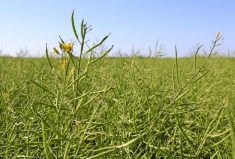CNS Canada — Participants in the canola market have their rain gauges out this week to see if heat-blasted sections of the Prairies get enough moisture to help the beleaguered crop.
“Many pockets of Western Canada are in desperate need of rain so that’s the feature right now,” said Keith Ferley of RBC Dominion Securities in Winnipeg.
Canola futures shot above the $500 per tonne mark in the November contract a few weeks ago due to the sizzling temperatures that caught many fields in mid-flower.
Read Also

U.S. grains: Soy futures set 15-month high after China agrees to purchases
U.S. soybean futures reached a 15-month high on Thursday after President Donald Trump’s administration said top-importer China agreed to buy tens of millions of tons of American crops in the next few years as part of a trade truce.
Over the past week canola has softened a bit, losing $6.50 to fall to $507.50 per tonne in November as of Wednesday’s close.
Prices could easily slide below the $500 mark, though, due to the volatility inherent in a weather market, Ferley said.
Mike Jubinville of ProFarmer Canada pegged the next level of support around $495 per tonne.
He also suspects acreage estimates of 22.8 million acres may have been too optimistic.
“I suspect it may be less than that due to the wet spring and the late reseeding,” he said.
Recent scattered rains and milder temperatures have helped to lower the threats facing the crop, Ferley said, and hot days with a high humidex reading and strong winds are less common than a few weeks back.
Still, he said, canola has other issues keeping the market in check.
“The big negative holding canola back is the Canadian dollar,” he said.
The loonie on Wednesday hit near the US79.5-cent mark, its highest point in 14 months.
The rise in the currency makes canola less attractive to crushers, which is why margins are under fire, according to Jubinville.
According to ICE Futures Canada data, the margin was $73 above the November futures, compared with $97 a month ago and $122 at the same point a year ago.
“Canola is relatively expensive now compared to other oilseeds,” he noted.
With values consolidating, Jubinville said the market looks like it will stay in that $495-$530 range for the time being, unless weather problems begin to intensify once more.
— Dave Sims writes for Commodity News Service Canada, a Winnipeg company specializing in grain and commodity market reporting. Follow CNS Canada at @CNSCanada on Twitter.












